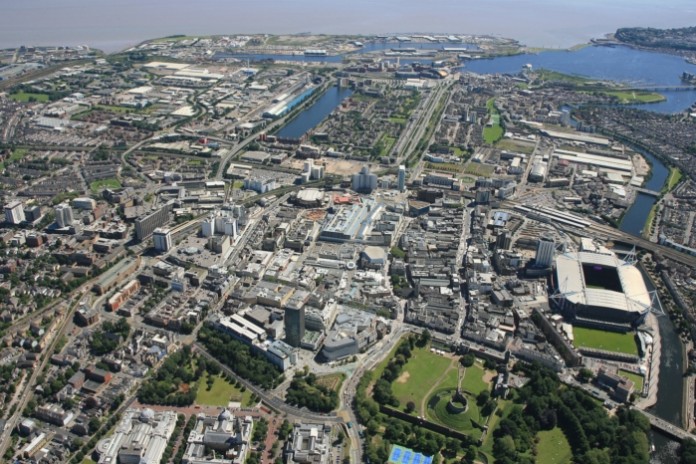New research carried out by property consultancy JLL into the Welsh property market shows that Cardiff has the most acute shortage of Grade A office space of all the eight core UK regional markets.*
With 2015 being a record-breaking year for occupier and investor demand, the Welsh Government needs to urgently incentivise new development if the city is to continue to capitalise on this over the next 12 months.
Chris Sutton, head of JLL’s Cardiff office, said: “The severe shortage of modern space for businesses, both in terms of offices and industrial space, risks having an adverse impact on inward investment and on the retention of existing businesses in Cardiff and south east Wales.”
He said that a balanced portfolio of development sites is also required including the potential for a science park and bespoke distribution site in south east Wales.
Today (Tuesday March 8), JLL, which has an office in Cardiff, is hosting its annual South Wales Property Market Review, which examines how the property market is performing and looks at what’s in store for the year ahead.
Only 0.6 per cent of Grade A office space is currently vacant in the capital city, which is the lowest vacancy rate of all the eight core regional markets, which led to 2015 also achieving the highest year-on-year increase in headline rents of 9.1 per cent to £24.00 per square foot. Manchester had the second highest rental increase of 6.3 per cent to £34.00 per square foot.
In the industrial markets, availability of space continues to be an issue with a lack of Grade A space causing a rise in headline rents. Around 3.59 million sq ft of industrial space was taken up in Wales in 2015, which was 22 per cent lower than in 2014 although this was, in part, because of a lack of modern buildings. There was just 11.39 million sq ft of industrial floorspace available across Wales by the end of last year, a drop of 9.7 per cent over 12 months and a reduction of 43.5 per cent over three years.
Chris Sutton said: “2015 was a record-breaking year in terms of both office take-up and the volume of investment in the city as we saw increased confidence from investors, occupiers and developers.
“The challenge is now to harness this growth and ensure the city can continue to meet the requirements of those looking to invest or move here.
“The Welsh Government must urgently incentivise investment in new development to address this shortage of supply. Further strategic planning work is also required to create an updated network of key employment sites and the Strategic Development Plan envisaged under the Planning (Wales) Act will be central to this.
“With the Cardiff economy expected to grow 2.1 per cent per year between now and 2020, it’s essential that the city provides the right spaces in the right places to facilitate this.
“Delivering major infrastructure projects, such as the M4 ‘Black Route’ and Metro proposals, will also be crucial in attracting investment and the business community should continue to press for the early completion of these schemes.
“These projects have the potential to make a huge difference to the economy of Cardiff, the wider city region and, indeed, the whole of Wales. For example, there are real opportunities to extend the Metro network across the region, acting as a catalyst for new development and regeneration.”
A week before the Government’s Budget is due to be announced, Chris Sutton said he would welcome the agreement of a City Deal as it would provide a new source of investment, as long as the choice of projects is strategic and helps improve the business environment.
JLL’s report shows that Wales was a standout performer with 2015 investment volumes across all market sectors pushing beyond £1billion for the first time as investors searched for value. Investment in out of town retail parks was particularly strong with the McArthurGlen Designer Outlet in Bridgend selling for £115.5million and Morfa Shopping Park in Swansea following close behind at £83.5million, representing 5.54 per cent and 6.0 per cent net initial yield respectively.
The office market also performed well with take-up of space at 617,000 sq ft – 34 per cent above the five year average of 462,000 sq ft, with 200,000 sq ft directly relating to BBC Cymru Wales and Public Health Wales pre-lets.
Rhydian Morris, director at JLL in Cardiff, said: “We expect pre-let activity to continue with Cardiff being the main focus. With encouraging economic and employment forecasts, we expect more speculative office development to start in 2016 although it’s unlikely that it will be at the scale and speed needed to meet current demand.”
Urban logistics continues to be a key driver for growth and development. The decision by Aldi and DPD Geopost to develop more than half a million sq ft of warehousing across two schemes in Wentloog demonstrates the economic impact of new urban logistics projects and the need for strategic planning to allow for more developments of this kind.
Chris concluded: “The ingredients for an exciting programme of redevelopment and renewal are in place for Cardiff and the wider region and it’s now for the public and private sector to seize the opportunity that’s on offer.”
*The eight core UK regional markets are Birmingham, Bristol, Cardiff, Edinburgh, Glasgow, Leeds, Manchester and Western Corridor (West London and Thames Valley).















